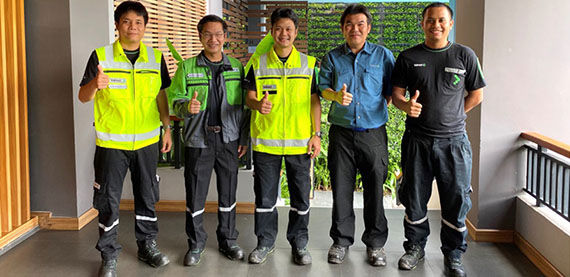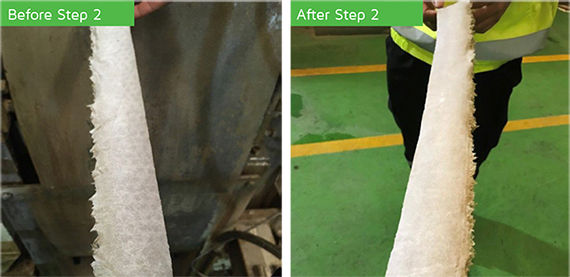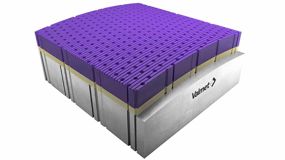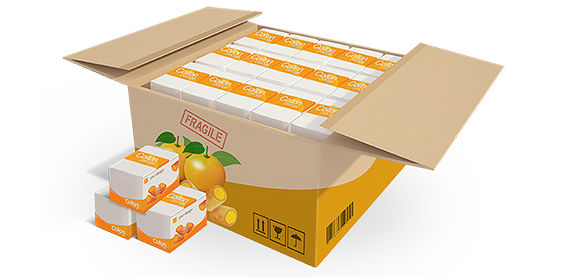From wet pressing to sustainability in Siam Kraft board mill
The redesign of the suction press roll cover has not only solved a persistent problem of shadow marking at Siam Kraft board mill. It has also helped the mill meet their goals for sustainability, cost-effectiveness and the circular economy by reducing fiber consumption.

In the scenic provincial town of Kanchanaburi Province in Thailand, SCGP’s Siam Kraft board mill strives for sustainability, cost-effectiveness and the circular economy. As part of SCGP’s Wangsala Mill complex, Siam Kraft produces coated duplex board with a white and smooth surface, suitable for offset printing. SCGP is one of the top corporations in Asia-Pacific and is known for the sustainable development of its business operations. Following in its parent’s footsteps, Siam Kraft has also been striving for sustainable and cost-effective operations and the circular economy.
However, as is typical of mills producing printed grades, Siam Kraft has been suffering from shadow marking in their PM9 press section.
“The issue of shadow marking was first brought to light almost coincidentally during a regular site visit,” says Kengkarn Jangsatiansuk, Manager, Thailand Service Sales, South East Asia, Valmet.

Valmet’s Laem Chabang service experts were able to meet the customer challenge with in-depth studies and Valmet Wet Pressing solutions
“Obviously, the persistent problem with shadow marking was also preventing the mill from achieving their sustainability goals due to the excessive consumption of working fibers, chemicals, other raw materials and energy. Consequently, this resulted in higher operating costs and shorter roll change and maintenance intervals,” Kengkarn Jangsatiansuk continues.“The mill expected solutions from us that would improve both press section performance and sustainability.”
3 steps to better press section performance
Valmet’s Laem Chabang service center in Thailand has a long history of cooperation with Siam Kraft. Their experts were able to meet this difficult challenge with in-depth studies and Valmet Wet Pressing solutions.

“The marks on the paper can be either a physical impression or a flow pattern, which can appear as a shadow or groove mark,” says Yutthapon Sittiwatjana, Paper Technology Manager.
“The marks on paper can either be a physical impression or a flow pattern, which can appear as a shadow or groove mark. Usually, this results from flow nip resistance causing lateral water movement into the sheet,” Yutthapon Sittiwatjana, Paper Technology Manager, South East Asia, Valmet, explains. “The flow pattern marks usually occur in the nips and can be caused by several factors such as high water loads or insufficient void volume under the compression caused by improper fabric design. Moreover, the non-uniform surface of a press roll, compacted felts or press felts which run too wet, and even roll cover that is too hard for a specific nip condition can contribute to the problem.”
To improve the press section performance of the PM9, Valmet’s service experts executed a three-step plan to understand the causes of the shadow marking problem and identify the correct solutions.
Step 1.
A water balance study revealed that the press section water removal was adequately managed by nip and uhle box dewatering. The source of the shadow marking was identified as the suction press center roll.
Step 2.
Based on Valmet Wet Pressing solutions, the roll cover of the suction press roll was redesigned with Valmet Press Roll Cover PK.
Step 3.
The vacuum system study indicated that the existing system had sufficient capacity to handle the process in a broad range.
It was also identified, that in the future, further optimization could be conducted with press felts and by changing the roll shell drilling patterns so that they are less sensitive to shadow marking.
Countable results in three months
|
As the main reason for shadow marking, the suction press roll was also the key to the major improvement. First, the suction press roll cover was changed to the softer Valmet Press Roll Cover PK to enable lower nip pressure and optimized cover surface structures for better nip uniformity. The lower nip pressure reduced shadow marking sensitivity. Replacing rubber with more durable polyurethane cover material then enabled more advanced drilling patterns and grooving, ensuring more effective water removal.
|
 |
Now, after three months of implementation, the redesign of the suction press roll cover has already exceeded all expectations. The problem of shadow marking has been solved, and the mill has gained countless benefits. They have been able to lower the consumption of the virgin fiber from 24 to 19 gsm. The total fiber consumption has also decreased, while quality and maintenance reliability have improved. In addition, the mill has been able to prolong their soft calender roll grinding intervals from 30 to 40 days, while benefiting from a lower total basis weight with controlled bulk and improved smoothness.

Wet pressing – on the way to sustainability
The results achieved at Siam Kraft PM9 prove that even the most difficult obstacles can be tackled with the right solutions. Sometimes, changing the water balance in the press section or nip condition is an effective way to solve shadow markings; sometimes, the secret just lies in choosing the right consumables.
With Valmet Wet Pressing solutions, mills in the pulp and paper industry can depend on a wide range of expert products and services. For Siam Kraft, only one was needed to solve the main problem with shadow marking. The redesign of the suction press roll cover with Valmet Press Roll Cover PK has not only solved a persistent problem of shadow marking, but has also helped the mill meet their goals for sustainability, cost-effectiveness and the circular economy by reducing fiber consumption.
The total fiber consumption has decreased, while quality and maintenance reliability have improved
Related articles


